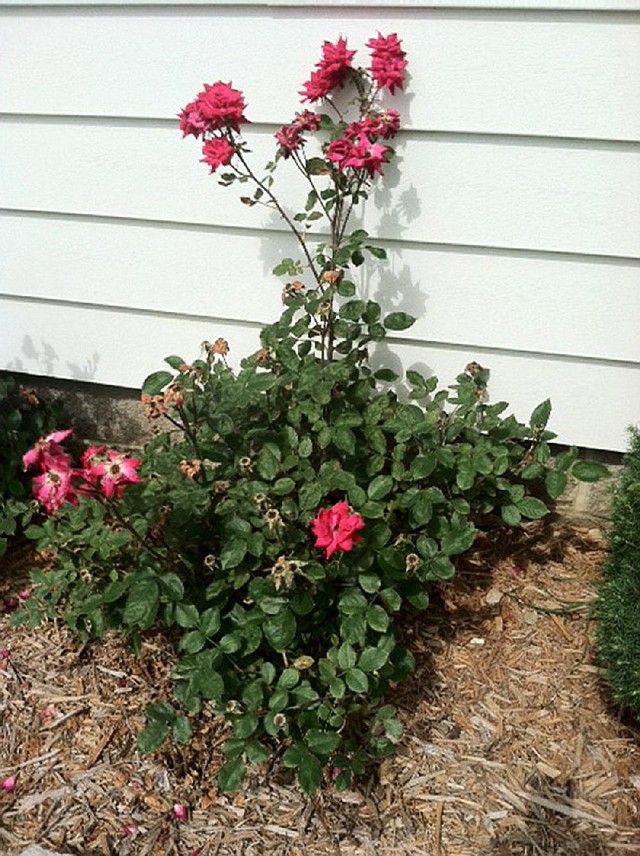In the garden
Saturday, June 15, 2013
Q Please tell me what I need to do.
These roses bloomed beautifully and now they are putting out long new growth, and the shorter parts are not putting on any new buds. Do I need to trim? If so, do I need to trim the new, tall shoots or just the short bushes? I have 14 of these, and this is the first year for them to bloom. Thank you for any help you can give me. I read you faithfully and saw your answer to the Knockout rose question recently, but I am still confused.
A I don’t think I have ever seen a Knockout rose throw a tall flower spike like that. Are you sure that it’s coming from a Knockout bush? I would definitely cut it back to the height of your rose bush. Our recommendation about pruning Knockout roses is changing. In the past, we said to prune in late February by one-third every year, but I recently found out that the mite that spreads rose rosette virus lives in the upper portions of rose bushes during the winter. Heavy pruning before new growth kicks in removes them, and thus the potential damage. One of the Knockout breeders encourages pruning the bushes back to 12 inches from the ground annually. If you think back to spring 2012, we moved into summer quickly and many people had blooming roses by late February, so they didn’t prune at all. We had more incidents of rose rosette last year than I have seen in a while, and I think this, in part, could explain it. If your plants get leggy during midsummer, a light haircut then can also thicken them up and encourage future blooms.
Q Several years ago I planted some vinca for ground cover on a slope at the end of my carport. It has migrated around to the front of my house and taken over one side of the flower bed, smothering out existing plants, including phlox and salvia. What is the best way to get rid of it once and for all? I’d like a solution that doesn’t include digging it up.
A Vinca major is the bane of my world.
It is a vigorous vine that completely covers my neighbor’s yard, and then migrates to mine. If it is just in your yard, you have a better chance of controlling it, but it won’t be easy. In the beds where you have desirable plants, try pulling the vinca out from those areas, in open spots weed-eat or mow down as much as you can, and spot spray with Roundup or another glyphosate product - in an area where you don’t have desirable vegetation. Wait a month, and if any regrows, repeat the process. Over time, you should be able to wear it out, but it is tenacious.
Q My peonies have finished blooming. Is now the time to cut them back or do I wait until fall? I know they are a bulb, but I’m not sure if I treat them like daffodils or not.
A Peonies are grown from a bulb-type fleshy root, but they are treated like a perennial, not a spring-blooming bulb. They will bloom in the spring and then remain as a green plant all summer.
Because they do start their growing season early, they often die down before a fall frost, but let them grow, keeping them watered throughout the summer.
When the foliage begins to die down, cut back the old leaves and wait for spring.
Q I have an ornamental pear and an edible pear tree in my yard, and they are both doing the same thing. The tips of the branches are turning brown, almost black. It is all over both trees, but just on the tips. Do you think someone has sprayed and they are getting sick from that? What can I do about it? We haven’t sprayed anything in our yard, but I can’t say that about my neighbors.
A I don’t think it is a chemical problem.
I think you have fireblight. Fireblight is a bacterial disease that is spread during bloom by pollinators. There is no spray cure for it. Preventive spraying during bloom with streptomycin or Agri-strep can give limited control, but when weather conditions are good, the disease spreads rapidly. For now, your only recourse is to prune out the damaged tips. The symptoms start with the tips of the branch looking burned with the end flagging over like a shepherd’s crook. The disease will stop spreading when temperatures reach 85 degrees, but it won’t go away. Cutting out the damaged branches 6 to 8 inches beneath where there is visible damage can help. Use a bleach solution to clean your pruners in between cuts, as you can spread the disease if you cut into diseased tissue then cut healthy tissue.
Janet Carson is a horticulture specialist for the University of Arkansas Cooperative Extension Service. Write to her at 2301 S. University Ave., Little Rock, Ark. 72204 or e-mail her at
HomeStyle, Pages 33 on 06/15/2013
